In stark contrast to veganism, the carnivore diet is composed of exclusively animal products, mainly meat. Though this goes against the common consensus that whole plant foods are healthy, many have experienced miraculous results after going on a 100% carnivore diet meal plan.
Unfortunately, these success stories are often followed by an overwhelming amount of misleading information regarding the benefits and risks of eliminating plants from your meals.
To help uncover the truth behind carnivorism and what this means for you, let’s take a closer look at the following topics:
- What is the carnivore diet?
- Science-backed benefits
- Downsides, risks, and dangers of eating only animal products
- Carnivore diet results
- Should you follow it?
- Carnivore food list: Only meat?
- Carnivore diet meal plan with recipes
- Carnivore vs. keto
- Key takeaways
What is the Carnivore Diet?
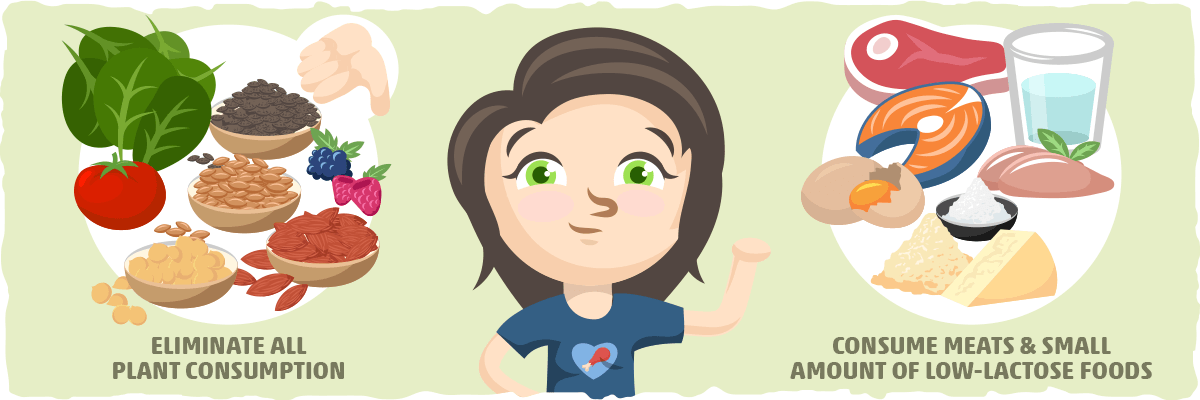
The carnivore diet involves eating only animal products. This means eliminating all plants and consuming mostly meat, water, and salt.
Many proponents of carnivorism also recommend limiting dairy intake as much as possible. Only foods that are low in lactose (milk sugar) such as butter and hard cheeses are permitted in small amounts.
This restrictive eating approach has been claimed to help induce rapid fat loss, reduce inflammation, reverse certain autoimmune conditions, heal chronic digestive issues, build muscle, and increase testosterone levels.
The Hypothesis Behind The Carnivorous Claims

Carnivore advocates tend to support their claims with a simple hypothesis: Plants are not optimal for human health because they contain compounds designed to harm animals.
Nuts and seeds, for example, tend to be the most heavily defended plant foods. They contain compounds that can provoke nutrient deficiencies and immune reactions.
Meat, on the other hand, doesn’t contain these potentially “toxic” compounds. Instead, you get highly bioavailable micronutrients, healthy fats, and complete proteins without excess carbs.
Equipped with this information, it may seem obvious that we should restrict plant foods. By doing so, however, we would have to ignore the preponderance of evidence supporting the health benefits of whole plant foods, including those that are heavily-defended.
Though a small group of people with specific autoimmune conditions or plant-triggered digestive issues may thrive on a carnivore diet, this doesn’t mean that it is the ideal approach for everyone. As with every other diet, there are several shades of grey we must consider so you can find the optimal approach for you.
Let’s take a closer look at the nuances behind carnivorism by uncovering the potential benefits, results, and risks of going plant-free.
The Science-backed Benefits of Following a Carnivore Diet
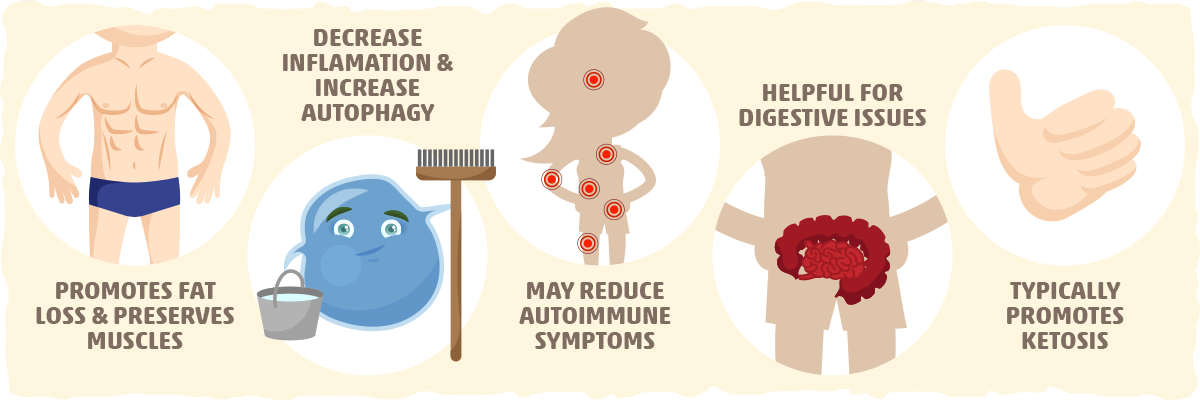
Since the carnivore diet has recently become a popular trend, there is no high-quality research on all-meat or 100% animal-based diets. We can, however, use the current literature on other diets and eating habits to better understand why going 100% carnivorous has gotten such glowing reviews:
● It promotes fat loss and muscle preservation.
No plants and more meat also means more protein and fewer carbs. This combination of carb restriction and higher protein consumption can help keep hunger under control.
Along with that, consuming more animal protein with each meal will stimulate muscle protein synthesis which helps build muscle and prevent muscle loss.
In other words, following a carnivore diet can help us achieve a more sculpted physique by promoting fat loss and muscle maintenance.
● It can help reduce inflammation and increase autophagy.
Calorie and carb restriction can help reduce inflammation levels and promote autophagy (the natural process of cell repair and damage cleanup). This can have a significant impact on someone’s overall wellbeing if they struggle with chronic inflammation and weight loss.
Keep in mind, however, that consuming high amounts of protein multiple times throughout the day can prevent autophagy. Without incorporating intermittent fasting with your carnivore diet, you may not experience these effects to the fullest.
● It has the potential to reduce autoimmune-related symptoms.
Adopting a meat-only carnivore approach eliminates most food allergens and sensitivities. This can help the body recover from chronic immune responses that are triggered by plant foods.
Mikhaila Peterson is a well-known advocate for this potential benefit. After suffering from chronic depression and rheumatoid arthritis for most of her life, she adopted an all-meat diet which helped clear up her debilitating symptoms.
● It may be helpful for digestive issues provoked by certain plant foods.
The Carnivore diet consists of easily digestible foods with minimal residue left behind. This type of low-residue diet can be helpful for symptoms of inflammatory bowel disease and irritable bowel syndrome that are provoked by plant fibers and other compounds.
Meat is made primarily of protein and fat, which are absorbed in the small intestine, leaving little residue leftover to irritate or inflame the gut. This can give the gut a chance to recover and rebuild.
The long-term effects of an all-meat diet on gut health and the microbiome, however, are not known.
● The carnivore diet typically promotes ketosis.
The carnivore diet is likely to induce nutritional ketosis for most people. That being said, it is possible to prevent high levels of ketone production by eating too much protein.
Since ketosis comes with a host of unique benefits that extend beyond what a carnivore diet can provide, we recommend following a keto-friendly approach if you are looking to give carnivorism a try. (We’ll learn how to implement a keto carnivore diet after considering the potential risks.)
The Other Side of the Story: Risk and Concerns
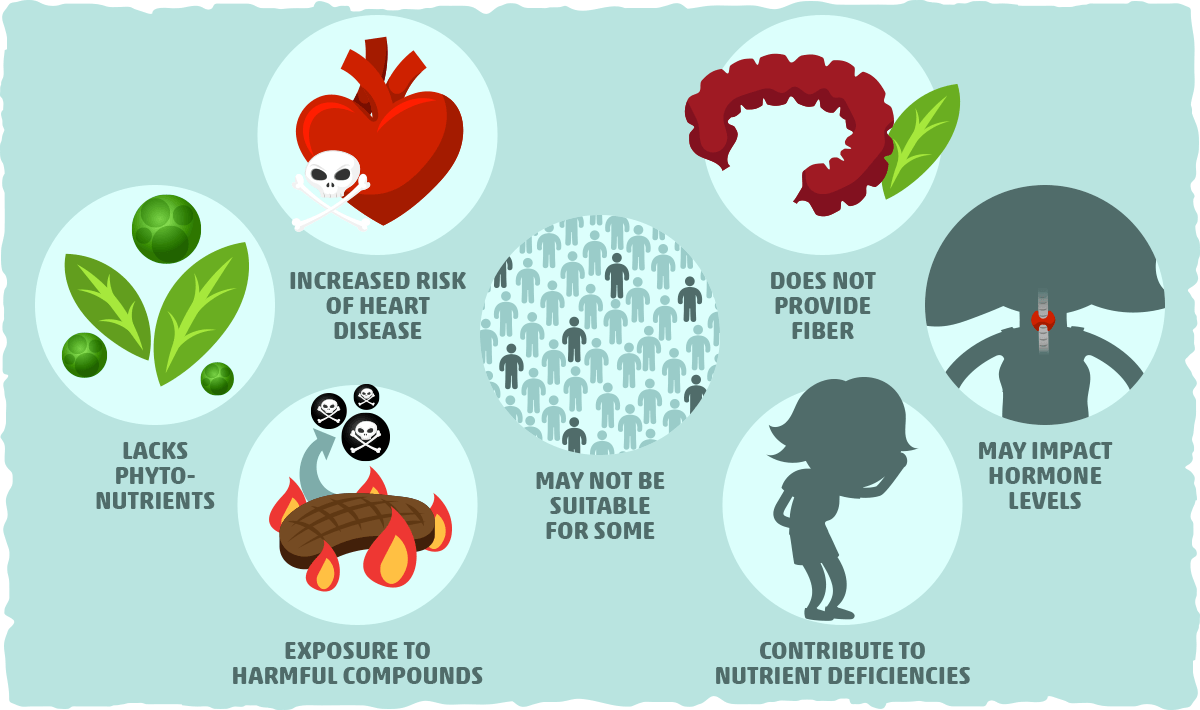
Due to its highly restrictive nature, there are many downsides to the carnivore diet. Though the potential for profound results may inspire hope, we must consider the benefits in light of the rest of the research literature.
By doing so, many risks emerge that should not be taken lightly:
● Increased risk of heart disease for some.
Given that the carnivore diet consists solely of animal foods, it tends to be higher in saturated fat. Saturated fat can raise LDL particle count (as well as total-to-HDL cholesterol ratio), which significantly increases the risk of heart disease.
Since there is a lot of misinformation surrounding how diet affects heart disease risk, we’ve included a link to our comprehensive article on the topic: The Ketogenic Diet and Heart Disease.
● May contribute to nutrient deficiencies.
While meat is nutritious and provides a diverse array of micronutrients, it doesn’t nourish our needs for every vitamin and mineral.
On a meat-only diet, these four nutrients will be particularly difficult to obtain in high quantities:
- Calcium — A mineral required for bone, muscle, and nerve health.
- Vitamin C — An antioxidant that boosts immune cell function and is crucial for collagen synthesis. Without consuming adequate amounts, we can develop scurvy and it’s unpleasant symptoms (i.e., weakness, fatigue, gum disease, skin problems, and joint pain).
- Vitamin E — An antioxidant that helps protect LDL particles from oxidizing and contributing to atherosclerosis.
- Vitamin K2 — A fat-soluble vitamin helps reduce the calcification of blood vessels.
However, this list assumes that you are eating organ meats and fatty fish. If you aren’t consuming organ meats (liver in particular) and seafood, we must add four more micronutrients to list:
- Vitamin A — crucial for eye health, skin health, and proper immune system function.
- Folate — A B vitamin that plays a key role in cell growth, metabolism, and methylation.
- Manganese — A trace mineral that is essential for detoxification.
- Magnesium — Supports more than 300 biochemical reactions, involving energy production, DNA repair, and muscle contraction.
That being said, it is possible to follow the diet for several years without any clear signs of nutrient deficiencies. Since nutrient requirements vary for each person, it is best to monitor your diet and health for nutrient deficiencies and their specific symptoms.
● Does not provide fiber.
Fiber is a non-digestible carb that promotes gut health, feeds our microbiome, and promotes healthy bowel movements. Since fiber solely exists in plant foods, the carnivore diet will not come with its benefits.
This may also provoke digestive issues as well, including constipation, diarrhea, and an increased risk of colon cancer for some. Though there is a lack of research on how an all-meat diet affects gut health, the current evidence suggests that it is healthier to have fiber in our diets.
That being said, I have come across anecdotal reports that suggest some people may benefit from cutting out fiber (and the compounds that accompany it) for a short period of time. This might alter the microbiome, gut, and immune system positively for those with certain gut conditions.
● Lacks health-promoting phytonutrients.
Advocates of the carnivore diet typically argue that phytonutrients (which includes the plant-defense compounds we learned about earlier) are unhealthy regardless of the dose.
This assertion, however, goes against the extensive literature on phytonutrients. In general, they have been found to reduce inflammation, enhance immunity, promote DNA repair, detoxify potential carcinogens, and reduce the risk of heart disease.
Though certain phytonutrients might be toxic in high doses, the current research suggests that the dose we get from whole plant foods is beneficial for most people.
● May have a significant impact on hormone levels.
Though there isn’t any long-term data on how an all-meat diet affects hormone levels, it is likely to impact thyroid function and fertility.
The combination of carbohydrate and calorie restriction, which commonly occurs with carnivorism, can reduce T3 levels and increase reverse T3. This indicates suboptimal thyroid function and may trigger symptoms like fatigue and brain fog.
With regards to fertility, the carnivore can be helpful or harmful depending on the person. On one end of the spectrum, an all-meat diet has the potential to promote fertility in women with PCOS (according to the research on the keto diet and PCOS) or severe autoimmune conditions (according to Mikhaila Peterson’s success story).
On the other hand, Shawn Baker — one of the most well-known carnivore advocates — ended up with low testosterone levels after following the diet, which may not be ideal for health and fertility.
As you can see, we don’t have much data to work with on this topic, so much more research is needed.
● Increased exposure to harmful compounds from high-heat cooking.
Meat cooked at high temperatures, particularly above 300 ºF (as in grilling or pan-frying), tends to contain more heterocyclic amines (HCAs). HCAs are mutagenic compounds that may increase the risk of cancer.
In other words, the quintessential carnivore meal, grilled steak, will come with high concentrations of potentially toxic compounds.
Along with HCAs, you are likely to find another mutagenic compound, known as polycyclic aromatic hydrocarbons (PAHs), sticking to the surface of the steak as well. This is because PAHs are created during the process of grilling or smoking meat.
Fortunately, there are two safe and easy ways to reduce your consumption of these toxins: (1) cook your meat low and slow (below 300 ºF) or (2) use a marinade that consists of herbs and spices.
Ideally, for the healthiest meat dish, you would cook it low and slow with herbs and spices. Consider using rosemary and/or thyme in your marinades, broths, and sauces as these herbs have been found to decrease the formation of HCAs the most.
● May not be suited for certain populations.
There are a few groups of people who may only be harmed by following the carnivore diet. This includes:
- People who have chronic kidney disease
- People who have familial hypercholesterolemia
- Anyone with particular nutrient requirements that are difficult to fulfill without plant foods (i.e., children and pregnant or lactating women)
What Are the Results of the Carnivore Diet? A Look at the Before and After
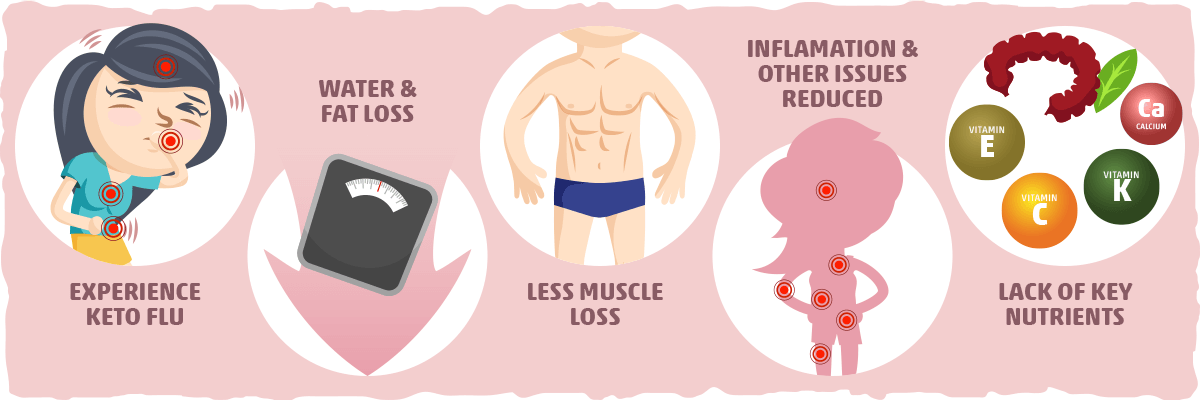
If you were to convert from a standard American diet to a 100% carnivorous approach for 2-3 months, the results would be similar to what you’d experience with the keto diet. At first, you would go through an adaptation period that may cause flu-like symptoms.
The number on the scale will go down rapidly as you shed off water weight. If the dietary shift naturally causes you to eat less food than before, then you will start losing fat as well. (The amount of fat lost will depend on the person.)
On most diets, some muscle is lost along with the fat. However, since the carnivore diet is typically higher in protein, a greater percentage of body fat will be lost. This can help us achieve a more sculpted physique.
Chronic inflammation, autoimmune-related symptoms, and digestive issues may also decrease significantly as well. This is where the differences between a mixed keto diet and a carnivore diet can shine through for anyone who feels worse after consuming plant foods.
Keep in mind, however, that the long-term effects of a 100% animal-based diet are not yet known. Given the fact that you won’t be getting fiber and may be deficient in key vitamins and minerals, this diet may only be feasible for a short-term trial of a few months.
The only data we have to rely on for the long-term health impact of this diet is from the popular carnivore proponent, Shawn Baker.
In a podcast interview with Robb Wolf, he shared his test results after converting to carnivore from a mixed ketogenic diet.
After one year without plants, this is what his numbers looked like:
- His total-to-HDL cholesterol ratio was 4.7, which indicates an increased heart disease risk.
- His fasting glucose level was 127. A healthy fasting blood glucose level is generally less than 100, and the American Diabetes Association considers anything 126 or over to be a sign of type 2 diabetes.
- His total testosterone was 237, which is low enough to medically classify him as having “low testosterone.”
Simply put, his results indicate a worsening of objective health across the board. Though he may feel good subjectively, the ideal diet for him would be one that improves both his well-being and objective health markers at the same time.
The same applies to us as well. This why is it important to be aware of the potential downsides and risks of following such a restrictive diet before giving it a try.
What This Means for You: Should You Go Carnivore?
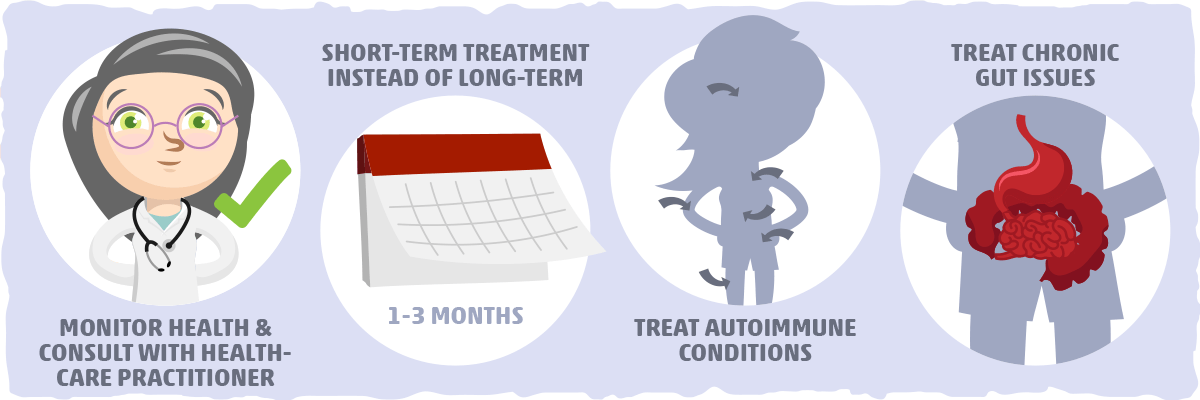
As with any major diet change, it is crucial to consult with your healthcare practitioner and monitor your health throughout the process.
The safest approach would be to use the carnivore diet as part of a short-term treatment protocol for a specific condition instead of a long-term lifestyle.
At this point, there are only two conditions that may benefit most from a short-term trial with this diet:
- Autoimmune conditions that are aggravated by a variety of plant foods
- Chronic gut issues that are relieved after reducing plant intake
In these cases, a nutrient-dense carnivore diet has the potential to decrease symptom flare-ups and promote recovery. A healthcare practitioner would then guide the patient through an incremental reintroduction of plant foods with the end goal of creating a less restrictive diet that doesn’t trigger symptoms.
As an example, a carnivore diet may be implemented for 1-3 months followed by a slow transition into a Mediterranean-style keto diet that features low-carb vegetables, healthy fats, and high-quality meats & fish.
Ideally, the carnivore diet will be composed of nutrient-dense animal foods like organ meats and well-tolerated seafood rather than the beef, salt, and water approach followed by Mikhaila Peterson. To give you a better idea of what this would look like, let’s take a deeper dive into the world of carnivorism.
The Different Types of Carnivore Diets: Land to Sea and Everything in Between
As with the keto diet, there are many variations of carnivorism. Mikhalia Peterson popularized a strict version of carnivore dieting that only includes meat (specifically ruminant meat), water, and salt. Her and her father, Jordan Peterson, attribute this diet as the cause of their miraculous mental and physical health transformations.
In contrast, Shawn Baker recommends a diet that incorporates a wider variety of animal foods as well as some herbs. Though he authored “The Carnivore Diet,” this may not be the optimal approach to carnivorism.
The most promising take on the diet is Dr. Paul Saladino’s tier-based model. He recommends a diversity of high-quality animal-based foods, emphasizing the importance of organ meats and nutrient-dense seafood.
Though this is the most nuanced of the carnivore diet plans, it does mitigate some of the risks while bolstering its benefits.
The Carnivore Diet Food List: What’s on the Menu?
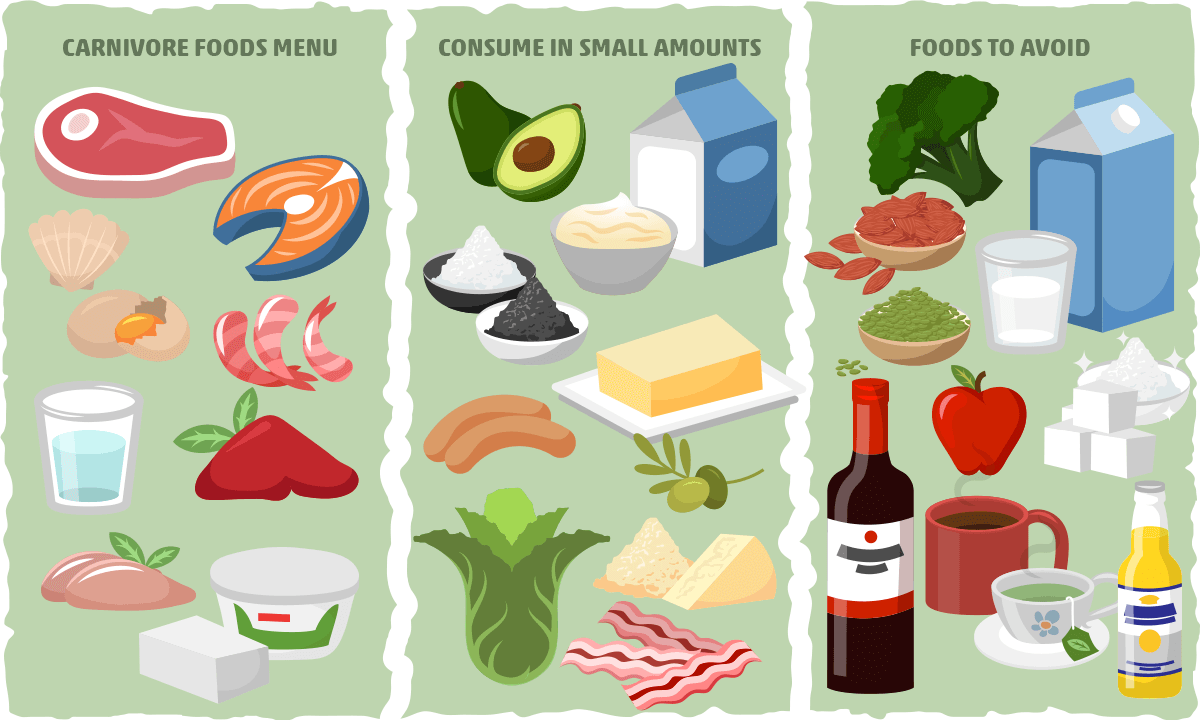
In general, these foods will be on the carnivore menu*:
- Meat — beef, chicken, turkey, lamb, pork, etc.
- Fish — salmon, mackerel, sardines, herring, etc.
- Shellfish — oysters, scallops, clams, shrimp, crab, lobster, etc.
- Other animal products — eggs, lard, bone marrow, bone broth, etc.
- Organ meats — suets, liver, kidney, heart, etc.
- Water — unflavored, sparkling or still
*Opt for 100% pasture-raised or wild-caught animal products whenever possible for a healthier variation of the carnivore diet.
Processed meats like bacon, sausage, and beef jerky are also allowed, but not recommended in high quantities.
These foods may be included in small amounts:
- Low-lactose dairy — heavy cream, hard cheese, butter, etc.
- Processed or smoked meats — bacon, sausage, beef jerky, etc.
- Seasonings — salt, pepper, and seasonings with no carbs are allowed in some cases.
- “Low-toxin” plants — according to Dr. Saladino, this includes olives, avocado, lettuce, cucumbers (without the skin and seeds), and various squashes.
Foods that are typically avoided on the carnivore diet include*:
- Vegetables — broccoli, cauliflower, potatoes, green beans, peppers, etc.
- Fruits — apples, berries, bananas, kiwi, oranges, etc.
- High-lactose dairy — milk, yogurt, soft cheese, etc.
- Legumes — beans, lentils, chickpeas, etc.
- Nuts and seeds — almonds, chia seeds, sunflower seeds, pistachios, etc.
- Grains — rice, wheat, quinoa, etc.
- Alcohol — beer, wine, liquor, etc.
- Added sugars — table sugar, maple syrup, honey, evaporated cane syrup, etc.
- Beverages other than water — soda, coffee, tea, fruit juice, etc.
When & How Much Should You Eat for Best Results?
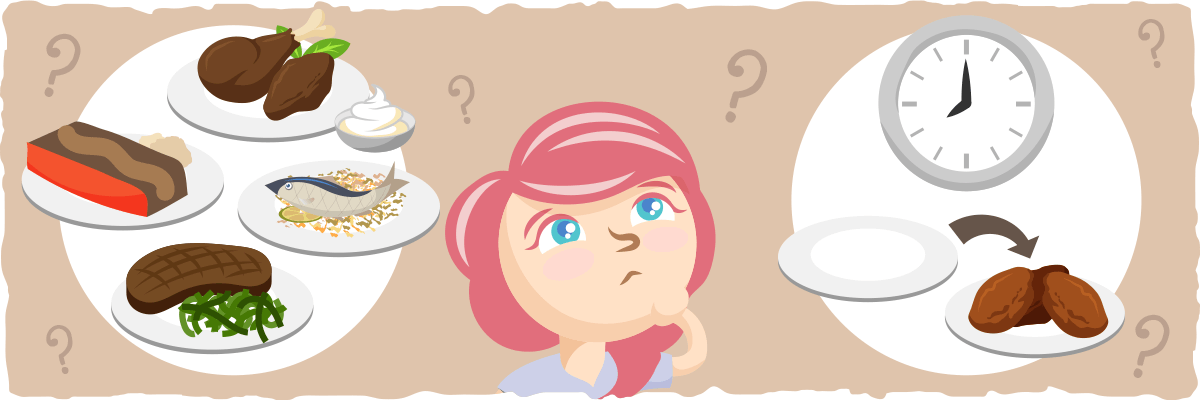
Most proponents of the diet suggest eating as often as you desire. Many carnivore dieters incorporate a form of intermittent fasting where they only eat one or two meals a day.
How much you eat and when you eat depends on what is sustainable for you. Since this diet can suppress your appetite in many ways, you will naturally eat fewer calories. This can lead to a significant amount of fat loss without having to track carbs and calories.
That being said, it is possible to eat so much meat and animal fat that you gain fat and prevent yourself from getting into ketosis. To help you fine-tune your diet and increase your chances of success, let’s take a look at a sample keto carnivore meal plan along with some tips and strategies on how to customize it for your needs.
A Transitional Keto Carnivore Diet Meal Plan With Recipes (>80% Carnivore)
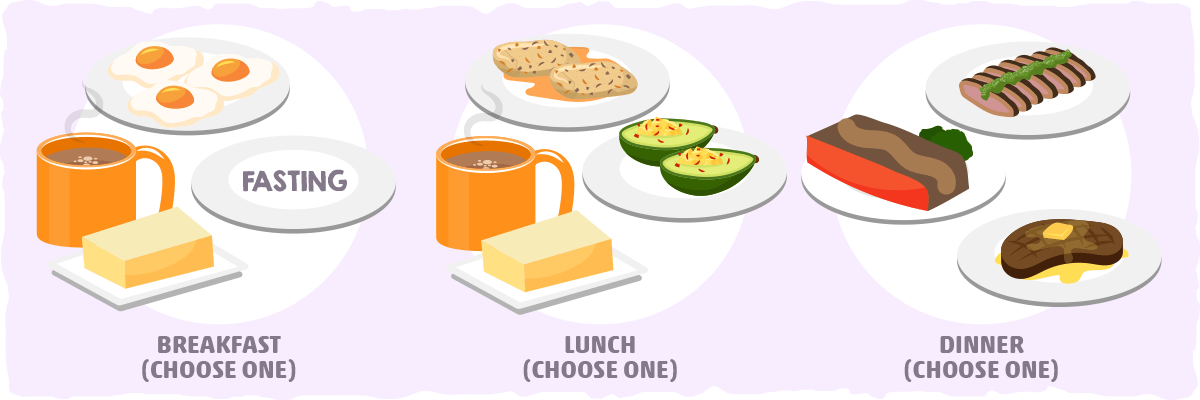
With this sample meal plan, I’ll give you a few options that you can tailor to your lifestyle, preferences, and nutrient needs. The serving size will vary depending on your hunger levels and body composition goals. To help you personalize your serving sizes for best results, use our keto calculator.
Breakfast (choose one of the following):
- 3-4 scrambled eggs with half an avocado and sea salt
- 1-2 cups of Ketoproof Coffee
- Continue to fast until lunch (Feel free to drink water, black coffee, and unsweetened tea as much as you want during this time.)
Lunch (choose one of the following):
- A cup of Ketoproof Coffee (for those who prefer to have one meal per day)
- 1 serving of Lemon & Rosemary Roasted Chicken Thighs
- 1-2 servings of Egg Salad Stuffed Avocado
Dinner (choose one of the following):
- A Perfect Ribeye Steak with a side of romaine lettuce, cucumbers, olives, and extra virgin olive oil dressing.
- Seared Skirt Steak with Cilantro Paste
- Salmon with Tarragon Dill Cream Sauce
A Simple 100% Keto Carnivore Meal Plan With Recipes
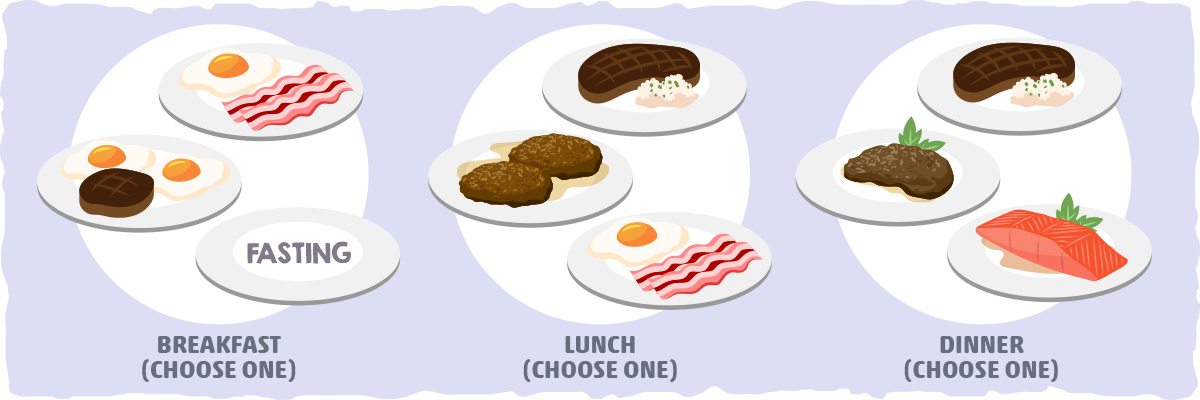
Once again, I’ll give you several options for each meal. To ensure that the meal plan is keto-friendly for you, keep your protein intake within the ranges recommended in the following section.
Breakfast (choose one of the following):
- 4 oz striploin steak and 2-3 eggs cooked in tallow, ghee, or bacon fat*
- Bacon and Eggs (prepared without any plant foods)*
- Continue to fast until lunch. (drink water with sea salt during this time — no coffee or tea allowed.)
Lunch (choose one of the following):
- 1 serving of Reverse Seared Ribeye Steak*
- 6-8oz lamb burgers cooked in tallow, ghee, or bacon fat*
- Bacon and Eggs (prepared without any plant foods)*
Dinner (choose one of the following):
- 1 serving of Reverse Seared Ribeye Steak*
- 1-2 servings of Slow-cooked Lamb Leg (prepared without any plant foods)*
- 6-8oz of Chinook (King) Salmon cooked in tallow or bacon fat*
*Supplement your meal with a few ounces of organ meats (especially liver), oysters, and/or wild-caught whole sardines for a healthier carnivore diet.
Discover more keto friendly carnivore diet recipes here.
Carnivore vs. The Keto Diet: Is the Carnivore Diet Keto?
Any diet that promotes sustained ketosis is technically a ketogenic diet. You can do this by eating all plant foods (i.e., with a vegan ketogenic diet), a mix of healthy animal and plant foods (i.e., with a Mediterranean keto diet), or with 100% meat diet (i.e., a keto carnivore diet).
As long as you restrict carbs low enough and eat the right amount of fat and protein to sustain ketosis, your diet is technically a keto diet.
The carnivore diet, in particular, primarily consists of food with almost zero carbs, which will restrict carb intake lower than a mixed keto diet. Though this can put you on the fast track to ketosis, strict carnivorism is not the golden ticket to a keto lifestyle. It is crucial that you monitor your protein intake as well.
Optimizing Your Carnivore Diet for Ketosis: Protein Intake Essentials
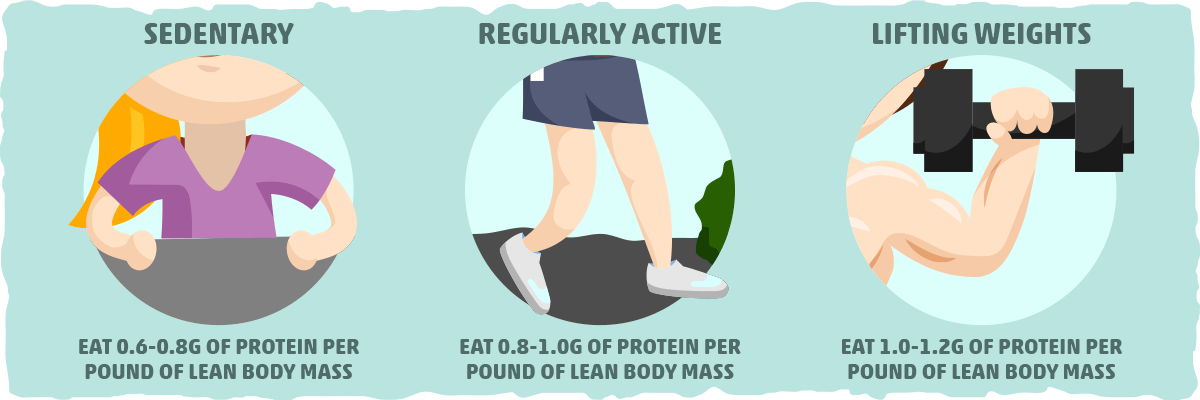
Without consuming the right balance of protein and fats, you may keep yourself from ketosis if your protein intake is high enough to increase insulin levels and suppress ketogenesis. The right strategy, however, is not to restrict protein.
By limiting protein intake, appetite levels and cravings tend to increase while precious muscle mass is broken down and repurposed. Over time, the underconsumption of protein can promote a skinny fat body composition by causing us to lose weight from all the wrong places.
The optimal strategy for protein intake is to eat the right amount based on your activity levels and body composition goals. You can find out what this means for you by using our keto calculator.
In general, most keto dieters will have no issue sustaining ketosis when they follow these guidelines:
- If you are sedentary — consume 0.6 – 0.8g of protein per pound of lean body mass.
- If you are regularly active — have 0.8 – 1.0g of protein per pound of lean body mass.
- If you lift weights — eat 1.0 – 1.2g of protein per pound of lean body mass.
Since carnivore dieters typically consume fewer carbs and calories, you may be able to eat slightly more protein than the top end of the above ranges without suppressing ketosis.
That being said, the effect of protein consumption on ketosis varies significantly from person to person. If you’d like to learn more about the relationship between protein & keto and how this applies to you, check out our guide to protein consumption and ketosis.
Key Takeaways: The Carnivore Diet & You
Given the highly restrictive nature of the carnivore diet, this approach comes with a massive potential for risks and benefits, depending on who adopts the diet.
According to the before & after anecdotes, the carnivore diet can help those with certain autoimmune conditions and digestive issues that are provoked by plant foods. It also has the potential to suppress appetite, promote significant amounts of fat loss, and preserve more muscle mass than other popular diets.
However, the research literature on other dietary patterns indicates that a carnivore diet comes with several risks as well. Among the potential harms are an increased risk of heart disease, cancer (with meat cooked at high temperatures), nutrient deficiencies, gut issues, and hormonal dysregulation.
If you decide to experiment with carnivorism, it is crucial that you consult your healthcare practitioner and monitor your health and well-being throughout the process. After 1-2 months of following your new approach, you will have a good idea of whether or not the diet is right for you.
To help you formulate the optimal plan for your health and fat loss goals, we’ve included several resources that will help you get the results you want:
- How to know if keto, carnivore, or any other diet is right for you
- How to lose weight
- A guide to weight loss plateaus
- Use our keto calculator to help personalize your diet
Sources
- Carnivore Diet Review: Benefits, Downsides, and Sample Menu — Healthline
- The Ketogenic Mediterranean Diet: Optimal Health and Weight Loss — Ruled.me
- What to Eat on a Carnivore Diet. Your Carnivore Diet Meal Plan! — Carnivore MD
- The Ketogenic Diet and Heart Disease — Ruled.me
- Vitamin E and cardiovascular disease. — NCBI
- High-protein, reduced-carbohydrate weight-loss diets promote metabolite profiles likely to be detrimental to colonic health. — NCBI
- Learn How To Avoid The Keto Flu [Symptoms & Remedies] — Ruled.me
- Well-done Meat Intake, Heterocyclic Amine Exposure, and Cancer Risk — NCBI
- Classification and Diagnosis of Diabetes: Standards of Medical Care in Diabetes—2018 | Diabetes Care — American Diabetes Association
- What is Ketosis? — Ruled.me
- Episode 385 – Dr. Shawn Baker – Carnivore Diet and Dr. Baker’s Blood Work — Robb Wolf
- A practical guide to male hypogonadism in the primary care setting — NCBI
- Phytonutrients as therapeutic agents. — NCBI
- Brush On The Marinade, Hold Off The Cancerous Compounds — Science Daily